CHRYSLER VOYAGER 2001 Service Manual
Manufacturer: CHRYSLER, Model Year: 2001, Model line: VOYAGER, Model: CHRYSLER VOYAGER 2001Pages: 4284, PDF Size: 83.53 MB
Page 501 of 4284

Symptom:
LEFT LOW BEAM HEADLAMP CIRCUIT SHORTED TO VOLTAGE
POSSIBLE CAUSES
FRONT CONTROL MODULE
GROUND CIRCUIT OPEN
HIGH BEAM AND LOW BEAM DRIVERS CIRCUITS SHORTED TOGETHER
LEFT HEADLAMP
LEFT LOW BEAM DRIVER CIRCUIT SHORTED TO VOLTAGE
WIRING PROBLEM
WIRING HARNESS INSPECTION
TEST ACTION APPLICABILITY
1 Turn the ignition on.
With the DRB, erase the Front Control Module DTC's.
Turn the headlamps on.
Switch the headlamps between high beam and low beam several times, pausing for
5 seconds in each position.
With the DRB, read Front Control Module DTC's.
Is this DTC present?All
Ye s®Go To 2
No®Go To 7
2 Turn the ignition off.
Disconnect the Left Headlamp harness connector.
Using a 12-volt test light connected to 12-volts, check the Ground circuit.
NOTE: The test light must illuminate brightly. Compare the brightness to
that of a direct connection to the battery.
Does the test light illuminate brightly?All
Ye s®Go To 3
No®Repair the Ground circuit for an open.
Perform BODY VERIFICATION TEST - VER 1.
3 Turn the ignition off.
Disconnect the Left Headlamp harness connector.
Disconnect the Front Control Module.
Measure the resistance between the Left High Beam Driver circuit and the Left Low
Beam Driver circuit at the Left Headlamp harness connector.
Is the resistance below 100.0 ohms?All
Ye s®Repair the Left High Beam Driver circuit for a short to the Left
Low Beam Driver circuit.
Perform BODY VERIFICATION TEST - VER 1.
No®Go To 4
472
EXTERIOR LIGHTING
Page 502 of 4284

TEST ACTION APPLICABILITY
4 Turn the ignition off.
Disconnect the Left Headlamp harness connector.
Disconnect the Front Control Module.
Turn the ignition on.
Measure the voltage of the Left Low Beam Driver circuit.
Is the voltage below 1.0 volt?All
Ye s®Go To 5
No®Repair the Left Low Beam Driver circuit for a short to voltage.
Perform BODY VERIFICATION TEST - VER 1.
5 Turn the ignition off.
Turn the Headlamps off.
Install a substitute Headlamp in place of the Left Headlamp.
Turn the ignition on.
With the DRB, erase the Front Control Module DTC's.
Turn the headlamps on.
Switch the headlamps between high beam and low beam several times, pausing for
5 seconds in each position.
With the DRB, read Front Control Module DTC's.
Does the DRB display this DTC?All
Ye s®Go To 6
No®Replace the original Left Headlamp Bulb.
Perform BODY VERIFICATION TEST - VER 1.
6 Turn the ignition off.
Inspect the wiring and connectors associated with the Left Low Beam Driver circuit.
Were any problems found?All
Ye s®Repair as necessary.
Perform BODY VERIFICATION TEST - VER 1.
No®Replace the Front Control Module.
Perform BODY VERIFICATION TEST - VER 1.
7 Turn the ignition off.
NOTE: Visually inspect the related wiring harness and circuits. Look for
any chafed, pierced, pinched, or partially broken wires.
NOTE: Visually inspect the related wiring harness connectors. Look for
broken, bent, pushed out, or corroded terminals.
Note: Refer to any Technical Service Bulletins (TSB) that may apply.
Were any problems found?All
Ye s®Repair as necessary.
Perform BODY VERIFICATION TEST - VER 1.
No®Test Complete.
473
EXTERIOR LIGHTING
LEFT LOW BEAM HEADLAMP CIRCUIT SHORTED TO VOLTAGE Ð
Continued
Page 503 of 4284
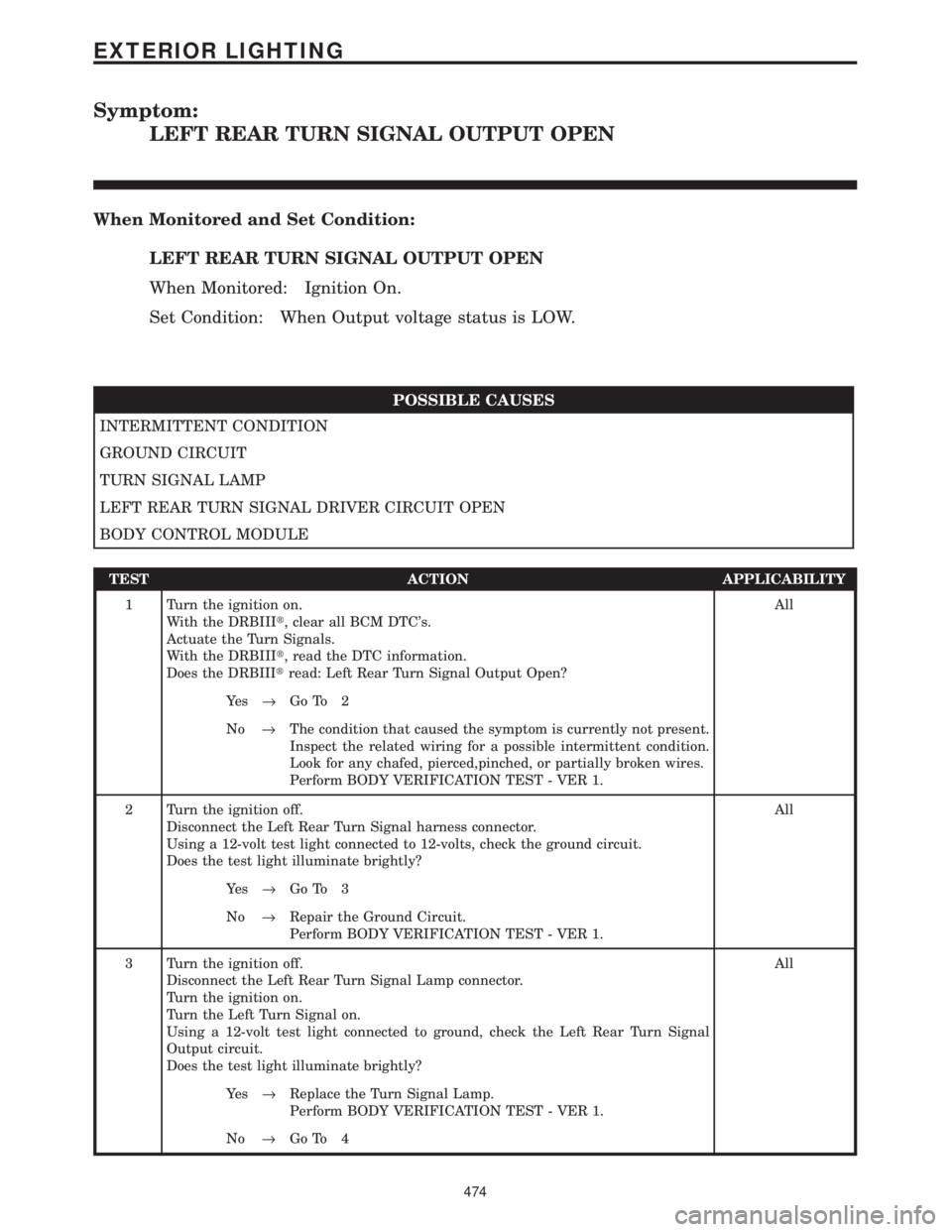
Symptom:
LEFT REAR TURN SIGNAL OUTPUT OPEN
When Monitored and Set Condition:
LEFT REAR TURN SIGNAL OUTPUT OPEN
When Monitored: Ignition On.
Set Condition: When Output voltage status is LOW.
POSSIBLE CAUSES
INTERMITTENT CONDITION
GROUND CIRCUIT
TURN SIGNAL LAMP
LEFT REAR TURN SIGNAL DRIVER CIRCUIT OPEN
BODY CONTROL MODULE
TEST ACTION APPLICABILITY
1 Turn the ignition on.
With the DRBIIIt, clear all BCM DTC's.
Actuate the Turn Signals.
With the DRBIIIt, read the DTC information.
Does the DRBIIItread: Left Rear Turn Signal Output Open?All
Ye s®Go To 2
No®The condition that caused the symptom is currently not present.
Inspect the related wiring for a possible intermittent condition.
Look for any chafed, pierced,pinched, or partially broken wires.
Perform BODY VERIFICATION TEST - VER 1.
2 Turn the ignition off.
Disconnect the Left Rear Turn Signal harness connector.
Using a 12-volt test light connected to 12-volts, check the ground circuit.
Does the test light illuminate brightly?All
Ye s®Go To 3
No®Repair the Ground Circuit.
Perform BODY VERIFICATION TEST - VER 1.
3 Turn the ignition off.
Disconnect the Left Rear Turn Signal Lamp connector.
Turn the ignition on.
Turn the Left Turn Signal on.
Using a 12-volt test light connected to ground, check the Left Rear Turn Signal
Output circuit.
Does the test light illuminate brightly?All
Ye s®Replace the Turn Signal Lamp.
Perform BODY VERIFICATION TEST - VER 1.
No®Go To 4
474
EXTERIOR LIGHTING
Page 504 of 4284
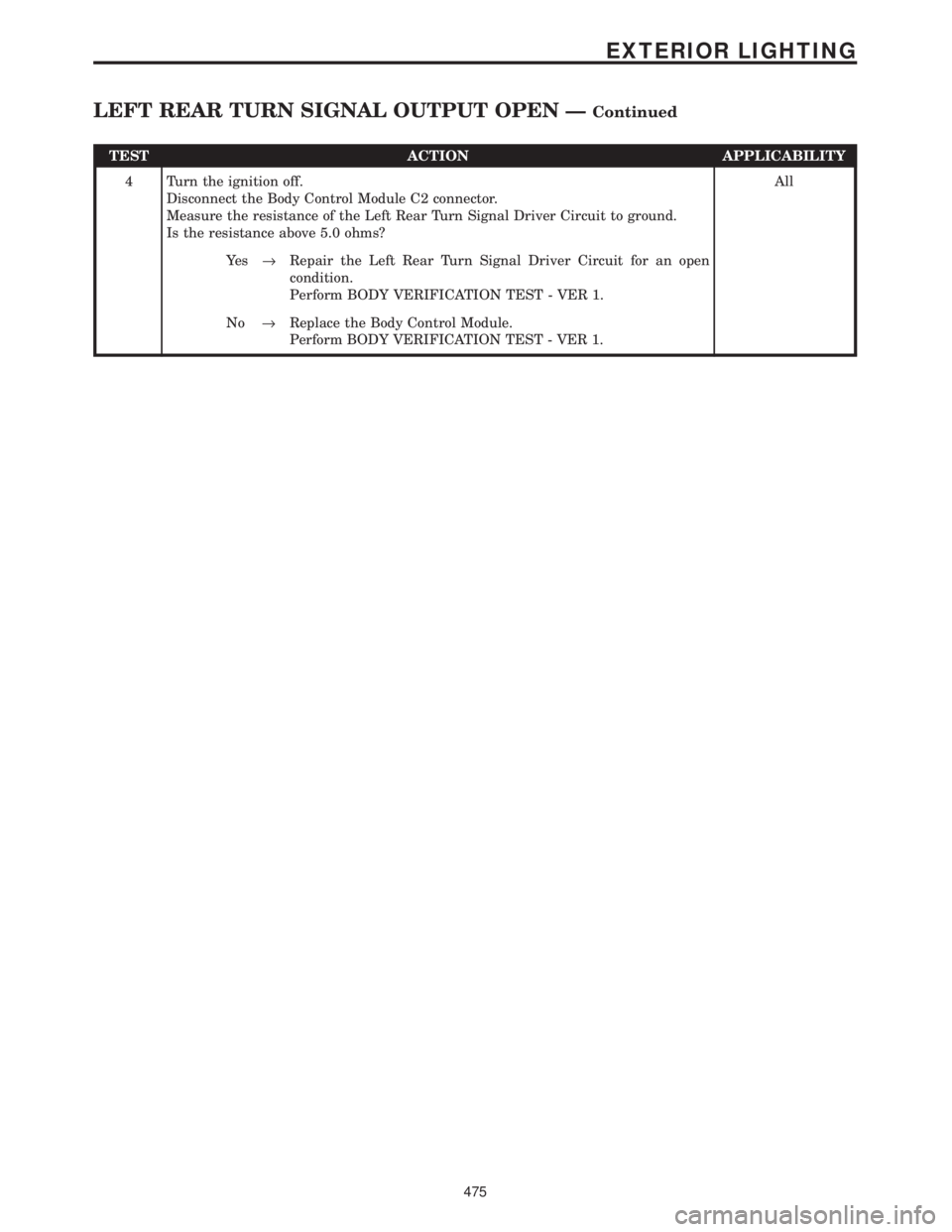
TEST ACTION APPLICABILITY
4 Turn the ignition off.
Disconnect the Body Control Module C2 connector.
Measure the resistance of the Left Rear Turn Signal Driver Circuit to ground.
Is the resistance above 5.0 ohms?All
Ye s®Repair the Left Rear Turn Signal Driver Circuit for an open
condition.
Perform BODY VERIFICATION TEST - VER 1.
No®Replace the Body Control Module.
Perform BODY VERIFICATION TEST - VER 1.
475
EXTERIOR LIGHTING
LEFT REAR TURN SIGNAL OUTPUT OPEN ÐContinued
Page 505 of 4284
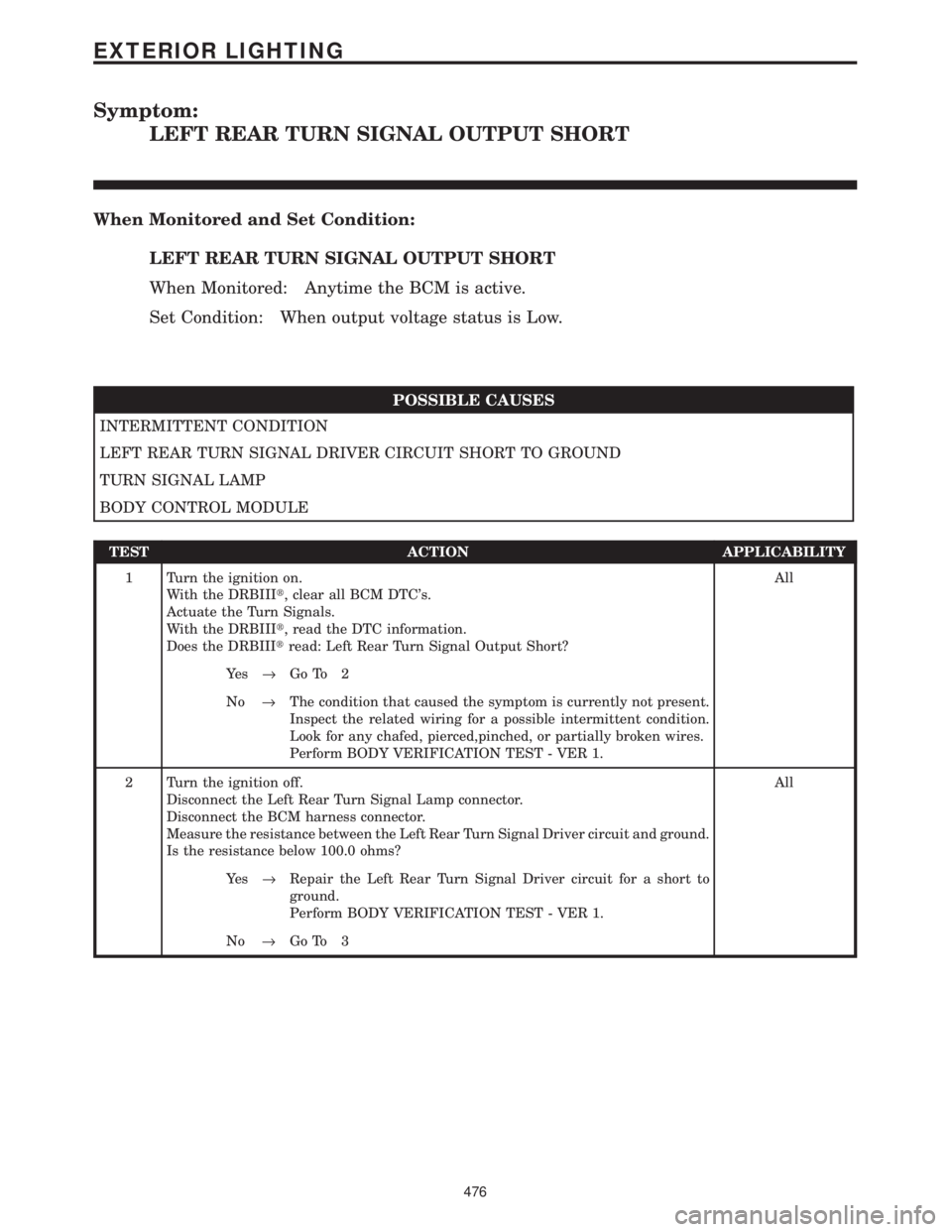
Symptom:
LEFT REAR TURN SIGNAL OUTPUT SHORT
When Monitored and Set Condition:
LEFT REAR TURN SIGNAL OUTPUT SHORT
When Monitored: Anytime the BCM is active.
Set Condition: When output voltage status is Low.
POSSIBLE CAUSES
INTERMITTENT CONDITION
LEFT REAR TURN SIGNAL DRIVER CIRCUIT SHORT TO GROUND
TURN SIGNAL LAMP
BODY CONTROL MODULE
TEST ACTION APPLICABILITY
1 Turn the ignition on.
With the DRBIIIt, clear all BCM DTC's.
Actuate the Turn Signals.
With the DRBIIIt, read the DTC information.
Does the DRBIIItread: Left Rear Turn Signal Output Short?All
Ye s®Go To 2
No®The condition that caused the symptom is currently not present.
Inspect the related wiring for a possible intermittent condition.
Look for any chafed, pierced,pinched, or partially broken wires.
Perform BODY VERIFICATION TEST - VER 1.
2 Turn the ignition off.
Disconnect the Left Rear Turn Signal Lamp connector.
Disconnect the BCM harness connector.
Measure the resistance between the Left Rear Turn Signal Driver circuit and ground.
Is the resistance below 100.0 ohms?All
Ye s®Repair the Left Rear Turn Signal Driver circuit for a short to
ground.
Perform BODY VERIFICATION TEST - VER 1.
No®Go To 3
476
EXTERIOR LIGHTING
Page 506 of 4284
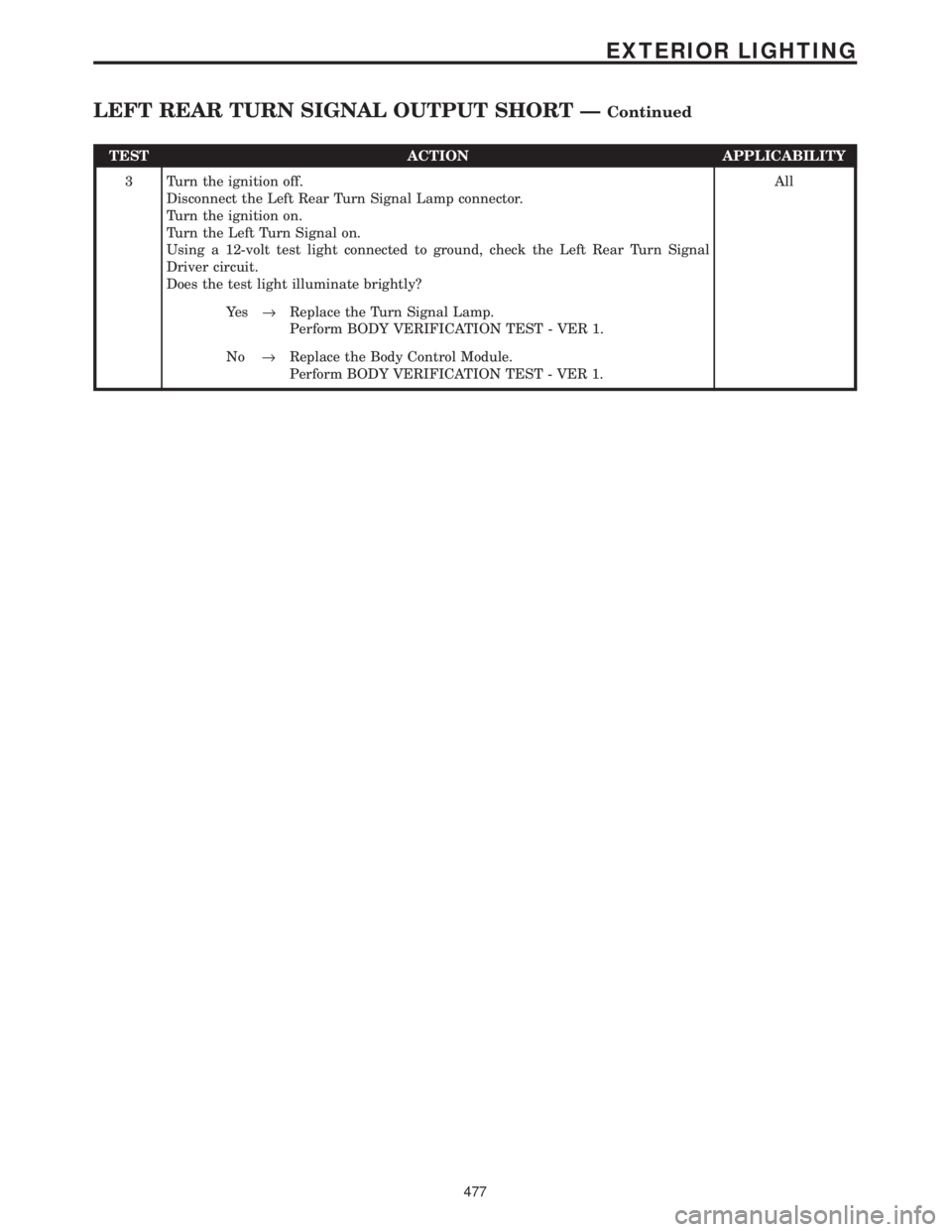
TEST ACTION APPLICABILITY
3 Turn the ignition off.
Disconnect the Left Rear Turn Signal Lamp connector.
Turn the ignition on.
Turn the Left Turn Signal on.
Using a 12-volt test light connected to ground, check the Left Rear Turn Signal
Driver circuit.
Does the test light illuminate brightly?All
Ye s®Replace the Turn Signal Lamp.
Perform BODY VERIFICATION TEST - VER 1.
No®Replace the Body Control Module.
Perform BODY VERIFICATION TEST - VER 1.
477
EXTERIOR LIGHTING
LEFT REAR TURN SIGNAL OUTPUT SHORT ÐContinued
Page 507 of 4284
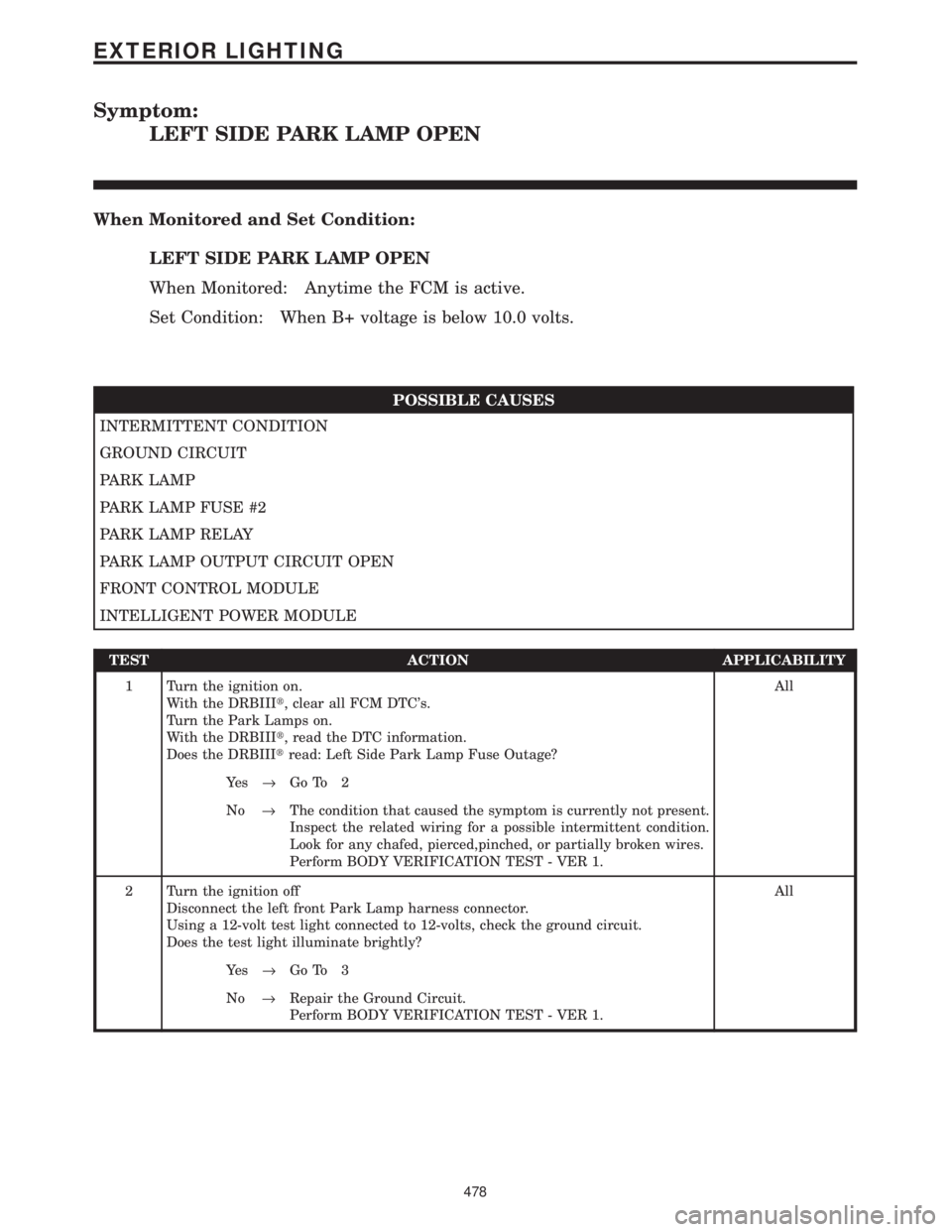
Symptom:
LEFT SIDE PARK LAMP OPEN
When Monitored and Set Condition:
LEFT SIDE PARK LAMP OPEN
When Monitored: Anytime the FCM is active.
Set Condition: When B+ voltage is below 10.0 volts.
POSSIBLE CAUSES
INTERMITTENT CONDITION
GROUND CIRCUIT
PARK LAMP
PARK LAMP FUSE #2
PARK LAMP RELAY
PARK LAMP OUTPUT CIRCUIT OPEN
FRONT CONTROL MODULE
INTELLIGENT POWER MODULE
TEST ACTION APPLICABILITY
1 Turn the ignition on.
With the DRBIIIt, clear all FCM DTC's.
Turn the Park Lamps on.
With the DRBIIIt, read the DTC information.
Does the DRBIIItread: Left Side Park Lamp Fuse Outage?All
Ye s®Go To 2
No®The condition that caused the symptom is currently not present.
Inspect the related wiring for a possible intermittent condition.
Look for any chafed, pierced,pinched, or partially broken wires.
Perform BODY VERIFICATION TEST - VER 1.
2 Turn the ignition off
Disconnect the left front Park Lamp harness connector.
Using a 12-volt test light connected to 12-volts, check the ground circuit.
Does the test light illuminate brightly?All
Ye s®Go To 3
No®Repair the Ground Circuit.
Perform BODY VERIFICATION TEST - VER 1.
478
EXTERIOR LIGHTING
Page 508 of 4284
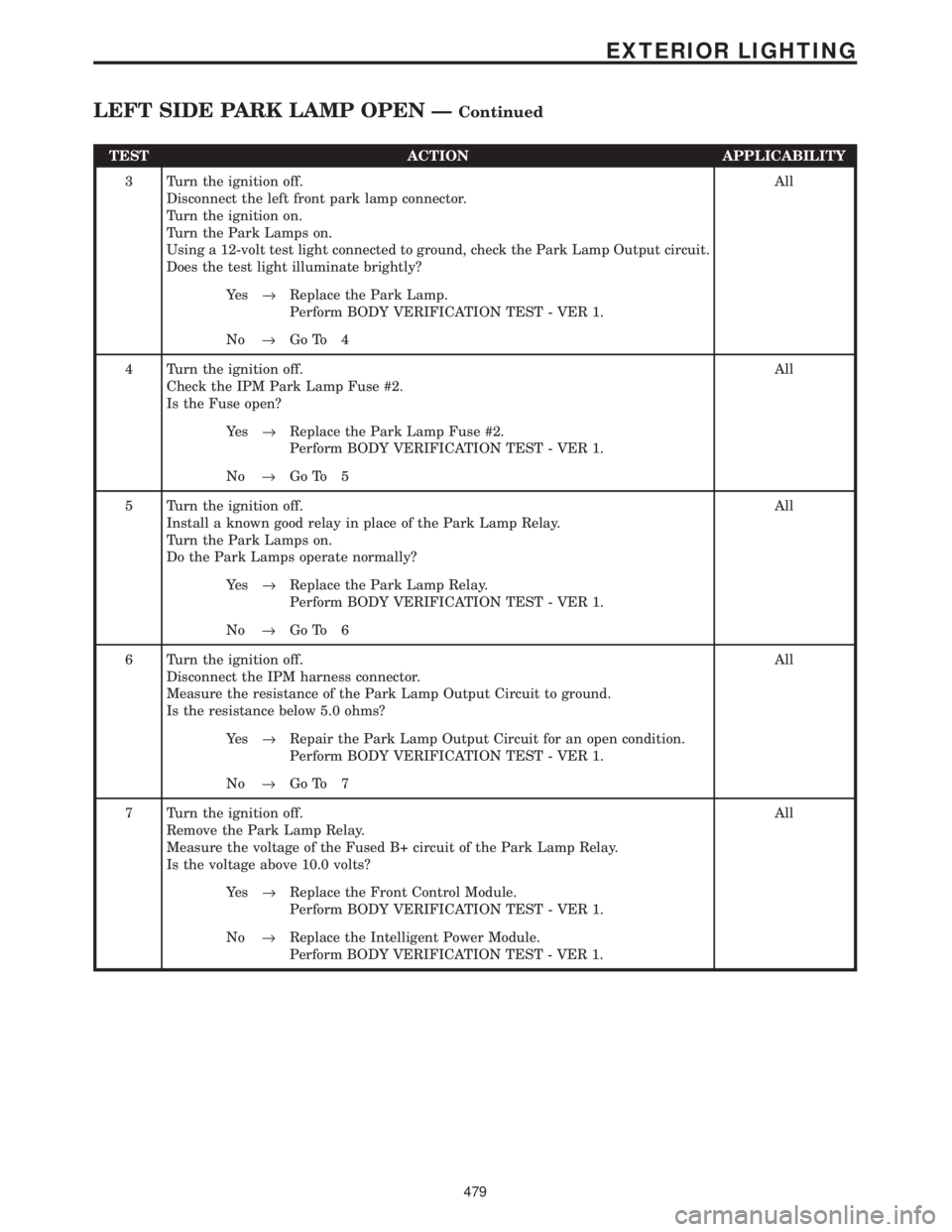
TEST ACTION APPLICABILITY
3 Turn the ignition off.
Disconnect the left front park lamp connector.
Turn the ignition on.
Turn the Park Lamps on.
Using a 12-volt test light connected to ground, check the Park Lamp Output circuit.
Does the test light illuminate brightly?All
Ye s®Replace the Park Lamp.
Perform BODY VERIFICATION TEST - VER 1.
No®Go To 4
4 Turn the ignition off.
Check the IPM Park Lamp Fuse #2.
Is the Fuse open?All
Ye s®Replace the Park Lamp Fuse #2.
Perform BODY VERIFICATION TEST - VER 1.
No®Go To 5
5 Turn the ignition off.
Install a known good relay in place of the Park Lamp Relay.
Turn the Park Lamps on.
Do the Park Lamps operate normally?All
Ye s®Replace the Park Lamp Relay.
Perform BODY VERIFICATION TEST - VER 1.
No®Go To 6
6 Turn the ignition off.
Disconnect the IPM harness connector.
Measure the resistance of the Park Lamp Output Circuit to ground.
Is the resistance below 5.0 ohms?All
Ye s®Repair the Park Lamp Output Circuit for an open condition.
Perform BODY VERIFICATION TEST - VER 1.
No®Go To 7
7 Turn the ignition off.
Remove the Park Lamp Relay.
Measure the voltage of the Fused B+ circuit of the Park Lamp Relay.
Is the voltage above 10.0 volts?All
Ye s®Replace the Front Control Module.
Perform BODY VERIFICATION TEST - VER 1.
No®Replace the Intelligent Power Module.
Perform BODY VERIFICATION TEST - VER 1.
479
EXTERIOR LIGHTING
LEFT SIDE PARK LAMP OPEN ÐContinued
Page 509 of 4284
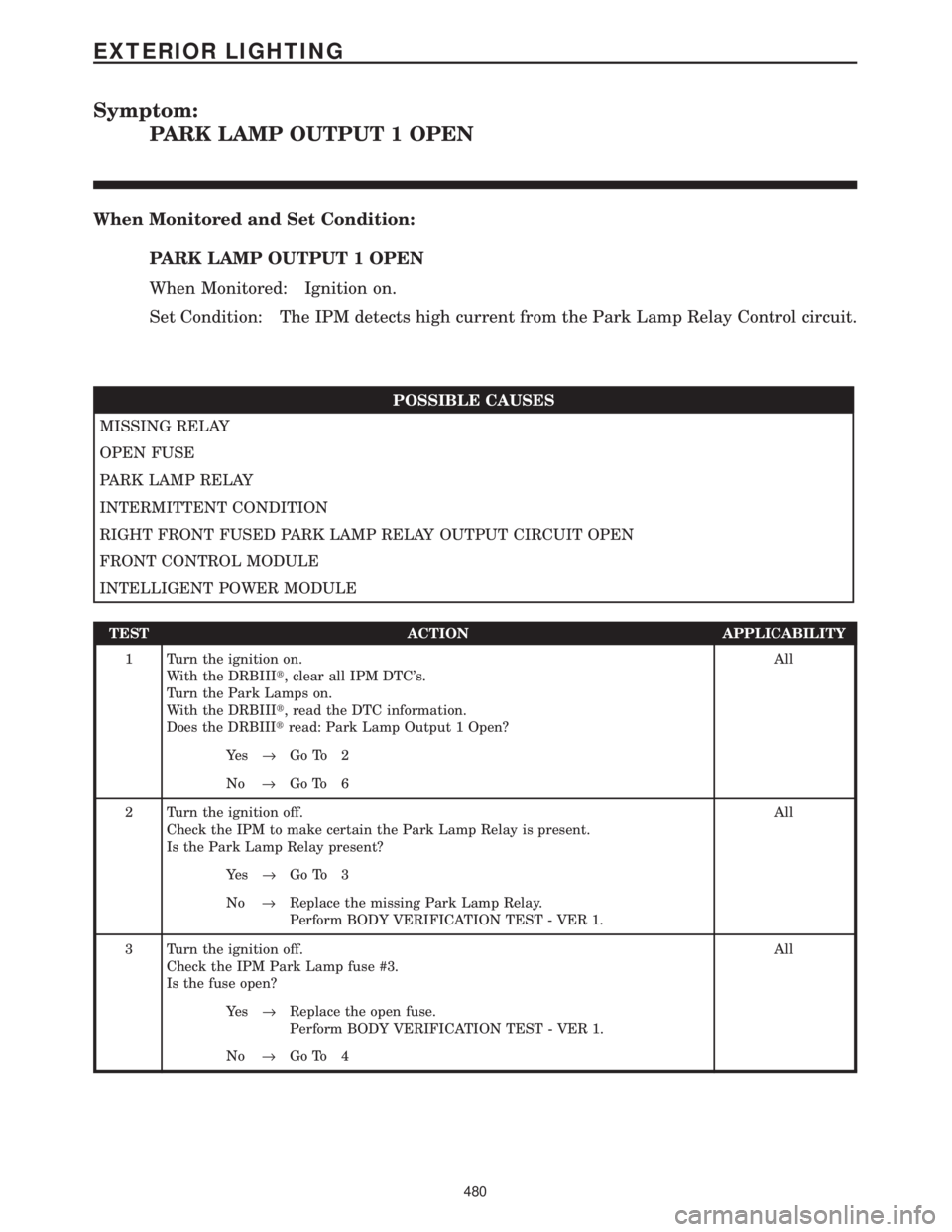
Symptom:
PARK LAMP OUTPUT 1 OPEN
When Monitored and Set Condition:
PARK LAMP OUTPUT 1 OPEN
When Monitored: Ignition on.
Set Condition: The IPM detects high current from the Park Lamp Relay Control circuit.
POSSIBLE CAUSES
MISSING RELAY
OPEN FUSE
PARK LAMP RELAY
INTERMITTENT CONDITION
RIGHT FRONT FUSED PARK LAMP RELAY OUTPUT CIRCUIT OPEN
FRONT CONTROL MODULE
INTELLIGENT POWER MODULE
TEST ACTION APPLICABILITY
1 Turn the ignition on.
With the DRBIIIt, clear all IPM DTC's.
Turn the Park Lamps on.
With the DRBIIIt, read the DTC information.
Does the DRBIIItread: Park Lamp Output 1 Open?All
Ye s®Go To 2
No®Go To 6
2 Turn the ignition off.
Check the IPM to make certain the Park Lamp Relay is present.
Is the Park Lamp Relay present?All
Ye s®Go To 3
No®Replace the missing Park Lamp Relay.
Perform BODY VERIFICATION TEST - VER 1.
3 Turn the ignition off.
Check the IPM Park Lamp fuse #3.
Is the fuse open?All
Ye s®Replace the open fuse.
Perform BODY VERIFICATION TEST - VER 1.
No®Go To 4
480
EXTERIOR LIGHTING
Page 510 of 4284
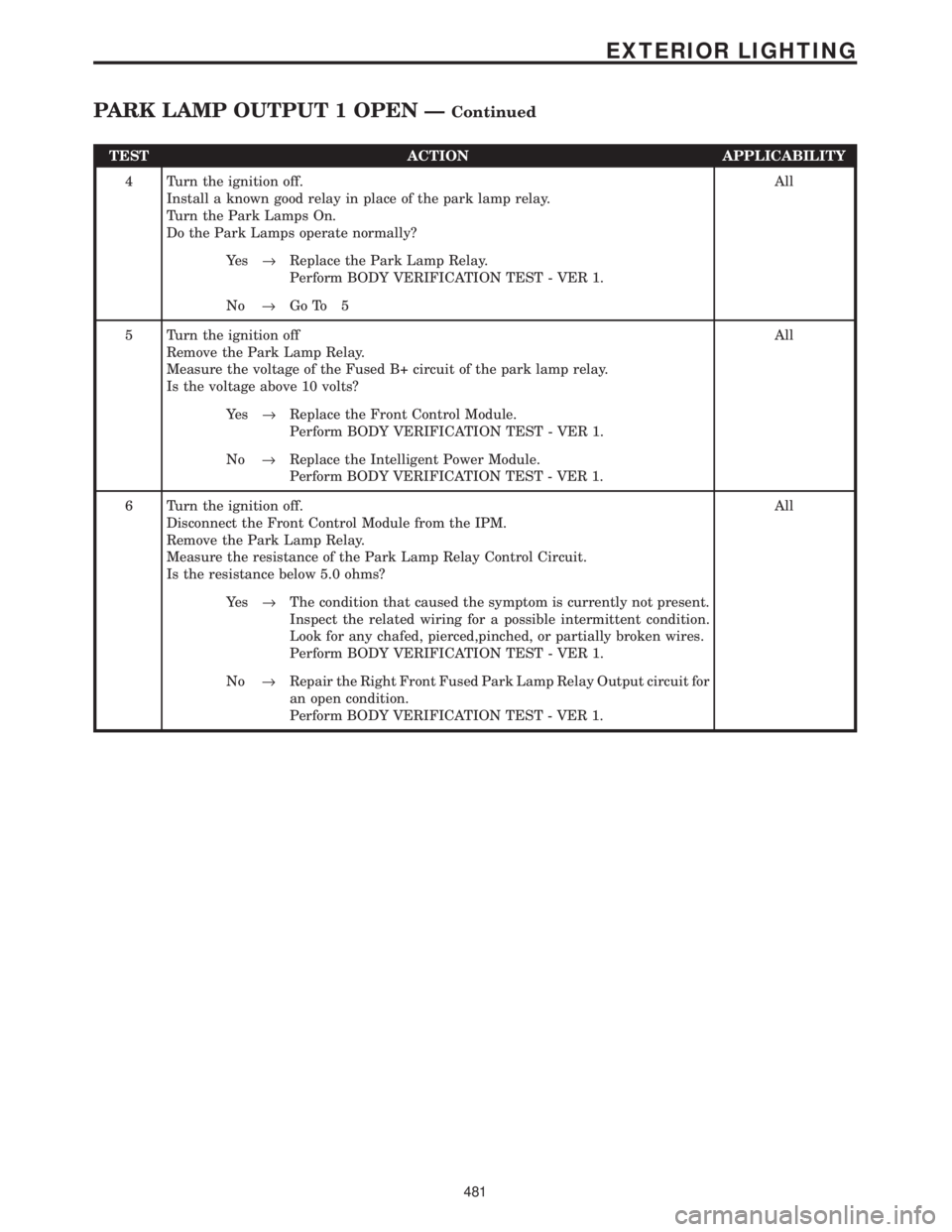
TEST ACTION APPLICABILITY
4 Turn the ignition off.
Install a known good relay in place of the park lamp relay.
Turn the Park Lamps On.
Do the Park Lamps operate normally?All
Ye s®Replace the Park Lamp Relay.
Perform BODY VERIFICATION TEST - VER 1.
No®Go To 5
5 Turn the ignition off
Remove the Park Lamp Relay.
Measure the voltage of the Fused B+ circuit of the park lamp relay.
Is the voltage above 10 volts?All
Ye s®Replace the Front Control Module.
Perform BODY VERIFICATION TEST - VER 1.
No®Replace the Intelligent Power Module.
Perform BODY VERIFICATION TEST - VER 1.
6 Turn the ignition off.
Disconnect the Front Control Module from the IPM.
Remove the Park Lamp Relay.
Measure the resistance of the Park Lamp Relay Control Circuit.
Is the resistance below 5.0 ohms?All
Ye s®The condition that caused the symptom is currently not present.
Inspect the related wiring for a possible intermittent condition.
Look for any chafed, pierced,pinched, or partially broken wires.
Perform BODY VERIFICATION TEST - VER 1.
No®Repair the Right Front Fused Park Lamp Relay Output circuit for
an open condition.
Perform BODY VERIFICATION TEST - VER 1.
481
EXTERIOR LIGHTING
PARK LAMP OUTPUT 1 OPEN ÐContinued